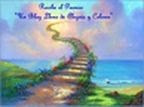The Spinner's Corner : On the upper left corner of the tribal home, a spinner stores her materials and tools. Occasionally , she sits here and spins. More often though, she will carry her tools on her shoulder to work outside with the other girls, be it the spinning wheel or the simpler spindle and bowl.
It is no wonder that she prefers to work elsewhere, for this crammed, windowless space is a mere 3 1/2" by 4" landing and rather poorly lit. Despite the small space, it has taken me 5 man days worth of work to complete making everything for my spinner.
I started preparations for the "Embroiderers' Workroom" on the Vesak Day weekend, i.e. 28th May. The "Spinner's Corner" is actually at the back part of that room.
I laid this little corner with a bamboo mat. You may remember from
"Ingredients for the House" that it is an old coaster I picked from the trash. The bundle against the wall is the white cloth trimmings of the coaster which I did not have the heart to throw away.
This spinning wheel is the 1st spinner's tool to be done. It was not made by me. I just aged an existing piece I bought from Daiso. Chisel is a good friend when aging. This is my first "sun bleached" look. By now, I am fairly confident with "dark" aging, something like what I did for
the door, using darker colours like brown and black but until this piece, I never had much success with "light" bleaching. This one is a compromise between the two, one I am fairly satisfied with but not before at least 100 layers of paint had been applied on it.
I nearly titled this post "A Spinner's Stool" because this stool took me so long to make. But I didn't use it because apart from sounding like something floating in a toilet bowl, I realised that almost a year ago, I already did a "Stools For Spinners" post. So I shifted the letters around and came up with "A Spinner's Tools".
This stool was modelled after a real one that I bought from Pakistan almost 20 years ago. As you can see, it is hardly used which explains its almost pristine condition. But I didn't want perky and youthful, I wanted age, stories, character.
This little thing and all of its 1 3/4" wide and 3/4" high frame took me a grand total of 3 days to make. Divide that up and you can imagine the millimeters I progressed each day with this chair. I even weaved the seat with threads to make it look as much like my real one as possible. I used wooden beads and toothpick for the frame and while chiselling the tiny beads, I cut my left thumb. This stool will never be thrown away for it is generously stained with my blood.

May I now share a tip in miniaturising a convincing chair: While you work, imagine how a homemade stool would not be perfect, how the seat sunk in after being sat on for 20 plus years, how the poor wooden frame is crooked from the weight it had to carry over the decades and how very old and dirty it must be after being handled roughly all those time. Either that, or spin a story around the chair after it is done according to how it turned out. I have to say though, this one is quite a bit better than the 3 I did, also in 3 days in
"Stools for the Spinners".
After the monumental task of making the stool, the rest was easy. In fact, I completed everything else in one day-yesterday, starting with this basket of spindles and 2 bowls. Inspired from a chapter in "Handmade In India" about hand-spinning wool, I thought these added a colourful touch to the otherwise somber corner.
I hope you will enlarge the picture to read the article. It is very short but informative. I know I kept referring to this book but I truly think this book is an invaluable source of information about art and craft in India.
The bowls in the book were made with apricot kernels (seed). I therefore used wooden bead for the inside, chiselled the hole till it is bigger and then encased it with seed husks from the palm oil tree in my garden, to simulate the kernel.
This is a shot of the colourful corner. Thank goodness for this post, at least someone will notice my "apricot kernel" bowls for the spindles.
The baskets were the last to be included. They were to be hung on the "thatched" walls of the room. I dyed each one a different brown with wood varnish I bought from Daiso. There's teak, mahogany, walnut, zelkonia (still trying to find out what in the world is that) and maple.
These baskets are used to hold all the materials for our spinners. Two of them hold flowers which can be used to dye the wool.
I picked this poster for the embroidered saddle (see bottom right of the picture) which serve as an inspiration to our embroiderers. It is a vintage print from India that I downloaded from the net.
Lastly, the little broom and the only thing I like from some ebay junk I bought some time back. Our Banjaran girls are very proud home owners and you will find most tribal homes kept very clean even if all the other things around the house are falling apart.
I need to make one more thing and I think the Embroiderer's Room will be complete.











































































































































































































